Torsten Hoefler
Performance Embeddings: A Similarity-based Approach to Automatic Performance Optimization
Mar 14, 2023



Abstract:Performance optimization is an increasingly challenging but often repetitive task. While each platform has its quirks, the underlying code transformations rely on data movement and computational characteristics that recur across applications. This paper proposes to leverage those similarities by constructing an embedding space for subprograms. The continuous space captures both static and dynamic properties of loop nests via symbolic code analysis and performance profiling, respectively. Performance embeddings enable direct knowledge transfer of performance tuning between applications, which can result from autotuning or tailored improvements. We demonstrate this transfer tuning approach on case studies in deep neural networks, dense and sparse linear algebra compositions, and numerical weather prediction stencils. Transfer tuning reduces the search complexity by up to four orders of magnitude and outperforms the MKL library in sparse-dense matrix multiplication. The results exhibit clear correspondences between program characteristics and optimizations, outperforming prior specialized state-of-the-art approaches and generalizing beyond their capabilities.
Myths and Legends in High-Performance Computing
Jan 06, 2023



Abstract:In this humorous and thought provoking article, we discuss certain myths and legends that are folklore among members of the high-performance computing community. We collected those myths from conversations at conferences and meetings, product advertisements, papers, and other communications such as tweets, blogs, and news articles within (and beyond) our community. We believe they represent the zeitgeist of the current era of massive change, driven by the end of many scaling laws such as Dennard scaling and Moore's law. While some laws end, new directions open up, such as algorithmic scaling or novel architecture research. However, these myths are rarely based on scientific facts but often on some evidence or argumentation. In fact, we believe that this is the very reason for the existence of many myths and why they cannot be answered clearly. While it feels like there should be clear answers for each, some may remain endless philosophical debates such as the question whether Beethoven was better than Mozart. We would like to see our collection of myths as a discussion of possible new directions for research and industry investment.
A Theory of I/O-Efficient Sparse Neural Network Inference
Jan 03, 2023



Abstract:As the accuracy of machine learning models increases at a fast rate, so does their demand for energy and compute resources. On a low level, the major part of these resources is consumed by data movement between different memory units. Modern hardware architectures contain a form of fast memory (e.g., cache, registers), which is small, and a slow memory (e.g., DRAM), which is larger but expensive to access. We can only process data that is stored in fast memory, which incurs data movement (input/output-operations, or I/Os) between the two units. In this paper, we provide a rigorous theoretical analysis of the I/Os needed in sparse feedforward neural network (FFNN) inference. We establish bounds that determine the optimal number of I/Os up to a factor of 2 and present a method that uses a number of I/Os within that range. Much of the I/O-complexity is determined by a few high-level properties of the FFNN (number of inputs, outputs, neurons, and connections), but if we want to get closer to the exact lower bound, the instance-specific sparsity patterns need to be considered. Departing from the 2-optimal computation strategy, we show how to reduce the number of I/Os further with simulated annealing. Complementing this result, we provide an algorithm that constructively generates networks with maximum I/O-efficiency for inference. We test the algorithms and empirically verify our theoretical and algorithmic contributions. In our experiments on real hardware we observe speedups of up to 45$\times$ relative to the standard way of performing inference.
PipeFisher: Efficient Training of Large Language Models Using Pipelining and Fisher Information Matrices
Nov 25, 2022



Abstract:Pipeline parallelism enables efficient training of Large Language Models (LLMs) on large-scale distributed accelerator clusters. Yet, pipeline bubbles during startup and tear-down reduce the utilization of accelerators. Although efficient pipeline schemes with micro-batching and bidirectional pipelines have been proposed to maximize utilization, a significant number of bubbles cannot be filled using synchronous forward and backward passes. To address this problem, we suggest that extra work be assigned to the bubbles to gain auxiliary benefits in LLM training. As an example in this direction, we propose PipeFisher, which assigns the work of K-FAC, a second-order optimization method based on the Fisher information matrix, to the bubbles to accelerate convergence. In Phase 1 pretraining of BERT-Base and -Large models, PipeFisher reduces the (simulated) training time to 50-75% compared to training with a first-order optimizer by greatly improving the accelerator utilization and benefiting from the improved convergence by K-FAC.
Spatial Mixture-of-Experts
Nov 24, 2022



Abstract:Many data have an underlying dependence on spatial location; it may be weather on the Earth, a simulation on a mesh, or a registered image. Yet this feature is rarely taken advantage of, and violates common assumptions made by many neural network layers, such as translation equivariance. Further, many works that do incorporate locality fail to capture fine-grained structure. To address this, we introduce the Spatial Mixture-of-Experts (SMoE) layer, a sparsely-gated layer that learns spatial structure in the input domain and routes experts at a fine-grained level to utilize it. We also develop new techniques to train SMoEs, including a self-supervised routing loss and damping expert errors. Finally, we show strong results for SMoEs on numerous tasks, and set new state-of-the-art results for medium-range weather prediction and post-processing ensemble weather forecasts.
GPTQ: Accurate Post-Training Quantization for Generative Pre-trained Transformers
Oct 31, 2022



Abstract:Generative Pre-trained Transformer (GPT) models set themselves apart through breakthrough performance across complex language modelling tasks, but also by their extremely high computational and storage costs. Specifically, due to their massive size, even inference for large, highly-accurate GPT models may require multiple performant GPUs to execute, which limits the usability of such models. While there is emerging work on relieving this pressure via model compression, the applicability and performance of existing compression techniques is limited by the scale and complexity of GPT models. In this paper, we address this challenge, and propose GPTQ, a new one-shot weight quantization method based on approximate second-order information, that is both highly-accurate and highly-efficient. Specifically, GPTQ can quantize GPT models with 175 billion parameters in approximately four GPU hours, reducing the bitwidth down to 3 or 4 bits per weight, with negligible accuracy degradation relative to the uncompressed baseline. Our method more than doubles the compression gains relative to previously-proposed one-shot quantization methods, preserving accuracy, allowing us for the first time to execute an 175 billion-parameter model inside a single GPU. We show experimentally that these improvements can be leveraged for end-to-end inference speedups over FP16, of around 2x when using high-end GPUs (NVIDIA A100) and 4x when using more cost-effective ones (NVIDIA A6000). The implementation is available at https://github.com/IST-DASLab/gptq.
Compressing multidimensional weather and climate data into neural networks
Oct 22, 2022Abstract:Weather and climate simulations produce petabytes of high-resolution data that are later analyzed by researchers in order to understand climate change or severe weather. We propose a new method of compressing this multidimensional weather and climate data: a coordinate-based neural network is trained to overfit the data, and the resulting parameters are taken as a compact representation of the original grid-based data. While compression ratios range from 300x to more than 3,000x, our method outperforms the state-of-the-art compressor SZ3 in terms of weighted RMSE, MAE. It can faithfully preserve important large scale atmosphere structures and does not introduce artifacts. When using the resulting neural network as a 790x compressed dataloader to train the WeatherBench forecasting model, its RMSE increases by less than 2%. The three orders of magnitude compression democratizes access to high-resolution climate data and enables numerous new research directions.
Neural Graph Databases
Sep 20, 2022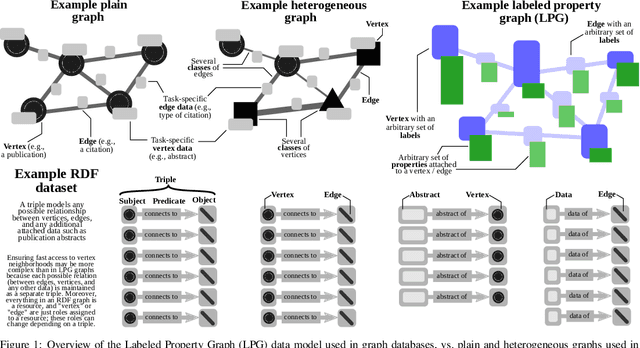

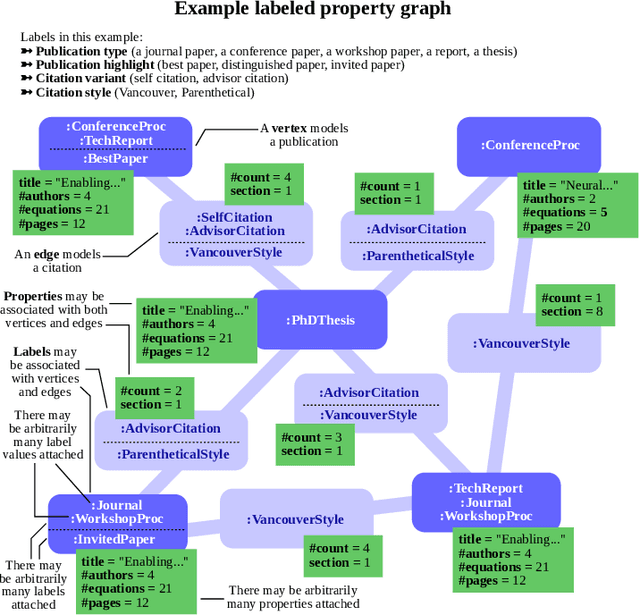
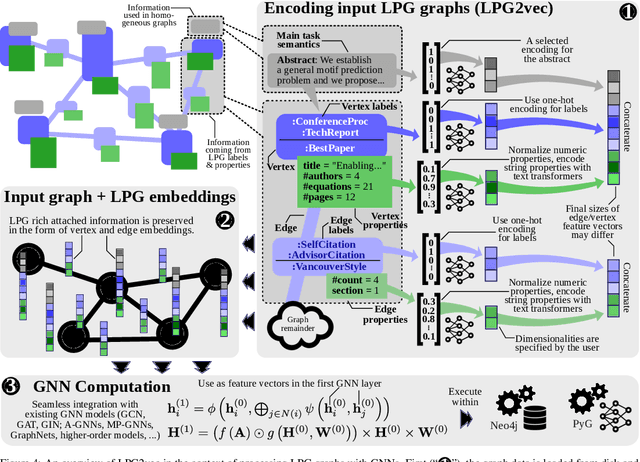
Abstract:Graph databases (GDBs) enable processing and analysis of unstructured, complex, rich, and usually vast graph datasets. Despite the large significance of GDBs in both academia and industry, little effort has been made into integrating them with the predictive power of graph neural networks (GNNs). In this work, we show how to seamlessly combine nearly any GNN model with the computational capabilities of GDBs. For this, we observe that the majority of these systems are based on, or support, a graph data model called the Labeled Property Graph (LPG), where vertices and edges can have arbitrarily complex sets of labels and properties. We then develop LPG2vec, an encoder that transforms an arbitrary LPG dataset into a representation that can be directly used with a broad class of GNNs, including convolutional, attentional, message-passing, and even higher-order or spectral models. In our evaluation, we show that the rich information represented as LPG labels and properties is properly preserved by LPG2vec, and it increases the accuracy of predictions regardless of the targeted learning task or the used GNN model, by up to 34% compared to graphs with no LPG labels/properties. In general, LPG2vec enables combining predictive power of the most powerful GNNs with the full scope of information encoded in the LPG model, paving the way for neural graph databases, a class of systems where the vast complexity of maintained data will benefit from modern and future graph machine learning methods.
Efficient Quantized Sparse Matrix Operations on Tensor Cores
Sep 14, 2022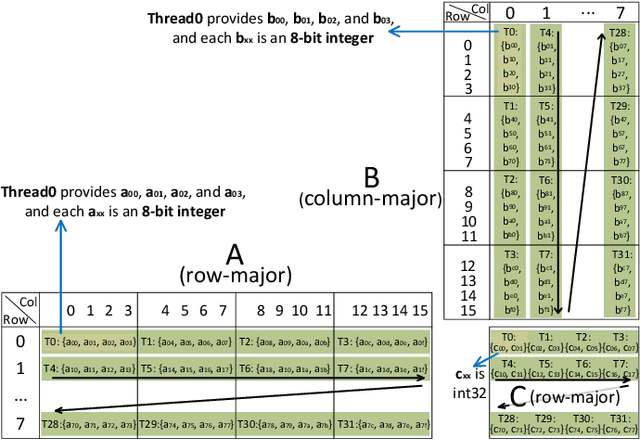
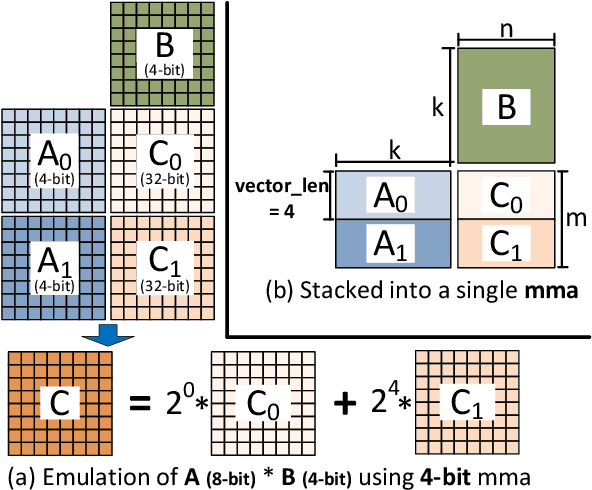


Abstract:The exponentially growing model size drives the continued success of deep learning, but it brings prohibitive computation and memory cost. From the algorithm perspective, model sparsification and quantization have been studied to alleviate the problem. From the architecture perspective, hardware vendors provide Tensor cores for acceleration. However, it is very challenging to gain practical speedups from sparse, low-precision matrix operations on Tensor cores, because of the strict requirements for data layout and lack of support for efficiently manipulating the low-precision integers. We propose Magicube, a high-performance sparse-matrix library for low-precision integers on Tensor cores. Magicube supports SpMM and SDDMM, two major sparse operations in deep learning with mixed precision. Experimental results on an NVIDIA A100 GPU show that Magicube achieves on average 1.44x (up to 2.37x) speedup over the vendor-optimized library for sparse kernels, and 1.43x speedup over the state-of-the-art with a comparable accuracy for end-to-end sparse Transformer inference.
HammingMesh: A Network Topology for Large-Scale Deep Learning
Sep 03, 2022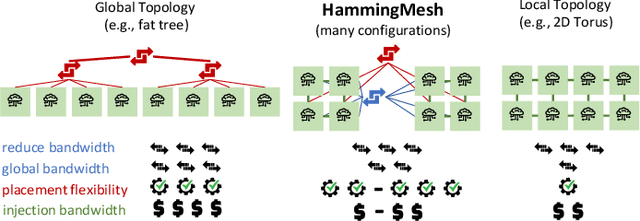

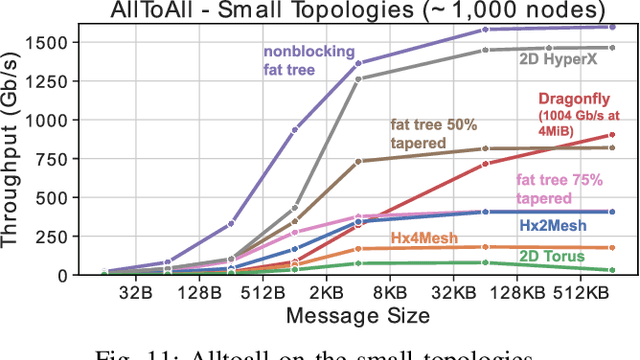
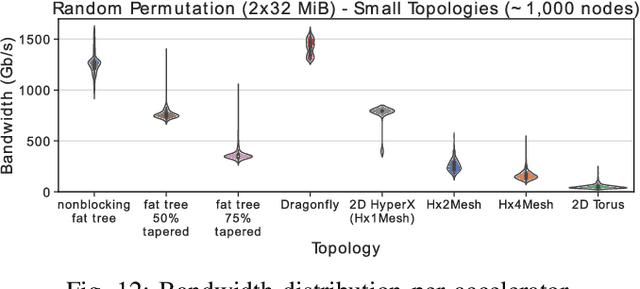
Abstract:Numerous microarchitectural optimizations unlocked tremendous processing power for deep neural networks that in turn fueled the AI revolution. With the exhaustion of such optimizations, the growth of modern AI is now gated by the performance of training systems, especially their data movement. Instead of focusing on single accelerators, we investigate data-movement characteristics of large-scale training at full system scale. Based on our workload analysis, we design HammingMesh, a novel network topology that provides high bandwidth at low cost with high job scheduling flexibility. Specifically, HammingMesh can support full bandwidth and isolation to deep learning training jobs with two dimensions of parallelism. Furthermore, it also supports high global bandwidth for generic traffic. Thus, HammingMesh will power future large-scale deep learning systems with extreme bandwidth requirements.
 Add to Chrome
Add to Chrome Add to Firefox
Add to Firefox Add to Edge
Add to Edge